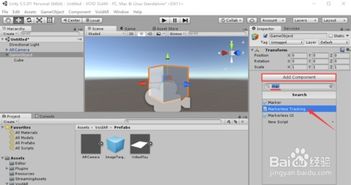A Frame Markerless AR Tutorial: A Comprehensive Guide for Beginners
Augmented Reality (AR) has become a popular technology in recent years, offering a unique blend of the digital and physical worlds. One of the most exciting aspects of AR is the ability to create interactive experiences without the need for physical markers. In this tutorial, we’ll explore how to create a markerless AR experience using A-Frame, a popular web framework for building virtual reality (VR) and AR experiences.
Understanding A-Frame

A-Frame is a web framework that allows developers to create VR and AR experiences using HTML and JavaScript. It provides a simple and intuitive way to build 3D scenes and integrate them with web content. A-Frame is built on top of WebVR, which is a set of web standards for building VR experiences.
One of the key features of A-Frame is its component-based architecture. This means that you can create your AR experience by combining various components, each with its own set of properties and behaviors. This makes it easy to customize and extend your AR experience.
Setting Up Your Development Environment

Before you start building your markerless AR experience, you’ll need to set up your development environment. Here’s a step-by-step guide to get you started:
- Install Node.js and npm: A-Frame requires Node.js and npm (Node Package Manager) to run. You can download and install Node.js from the official website (https://nodejs.org/).
- Install A-Frame: Once you have Node.js and npm installed, you can install A-Frame by running the following command in your terminal:
npm install aframe --save-dev- Set up your project: Create a new directory for your project and navigate to it in your terminal. Then, create a new HTML file (e.g., index.html) and add the following code to include A-Frame in your project:
<script src="https://aframe.io/releases/1.2.0/aframe.min.js"></script>Creating a Basic Markerless AR Scene

Now that you have your development environment set up, let’s create a basic markerless AR scene. In this example, we’ll create a simple scene with a 3D cube that appears in the real world when you point your device’s camera at it.
Open your index.html file and add the following code:
<body> <script src="https://aframe.io/releases/1.2.0/aframe.min.js"></script> <script> AFRAME.registerComponent('markerless', { schema: { model: { type: 'string' } }, init: function () { var model = this.data.model; var entity = document.createElement('a-entity'); entity.setAttribute('gltf-model', model); entity.setAttribute('position', '0 0 0'); this.el.appendChild(entity); } }); var scene = document.querySelector('a-scene'); scene.setAttribute('markerless', { model: 'https://cdn.aframe.io/models/cube/cube.gltf' }); </script></body>This code creates a new component called ‘markerless’ that adds a 3D model to the scene. The ‘model’ property specifies the URL of the 3D model you want to use. In this example, we’re using a simple cube model from the A-Frame CDN.
Customizing Your AR Experience
Now that you have a basic markerless AR scene, you can start customizing it to suit your needs. Here are some ways you can extend your AR experience:
- Adding Interactions: You can add interactions to your AR objects by using A-Frame’s built-in components, such as ‘click’ or ‘hover’.
- Changing the Model: Replace the cube model with any 3D model you like by updating the ‘model’ property in the ‘markerless’ component.
- Adding Textures: Apply textures to your 3D models to make them more realistic and visually appealing.
- Animating the Model: Use A-Frame’s ‘animation’ component to animate your 3D models.









